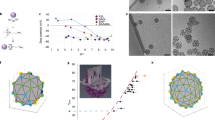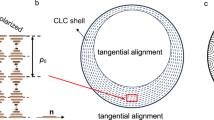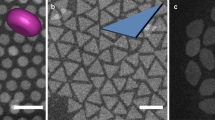Abstract
Patterning nano-objects is an exciting interdisciplinary research area in current materials science, arising from new optical and optoelectronic properties and the need to miniaturize electronic components1,2. Many techniques have been developed for assembling nanoparticles into two- and three-dimensional arrays3. Most studies involving liquid crystals as templates have dealt with colloidal particles and nematic and smectic phases4,5,6,7,8,9,10,11. Here, we demonstrate the long-range ordering of nanoparticle assemblies that adopt the helical configuration of the cholesteric liquid crystalline phase. Because we used glass-forming cholesterics, the nanostructures could be examined by transmission electron microscopy. The platinum nanoparticles form periodic ribbons that mimic the well-known 'fingerprint' cholesteric texture. Surprisingly, the nanoparticles do not decorate the original cholesteric texture but create a novel helical structure with a larger helical pitch. By varying the molar fraction of cholesterol-containing mesogen in the liquid crystal host, we show that the distance between the ribbons is directly correlated to the pitch. Therefore this inherent lengthscale becomes a simple control parameter to tune the structuring of nanoparticles. These results demonstrate how such an assembly process could be modulated, providing a versatile route to new materials systems.
Similar content being viewed by others
Main
We used siloxane liquid crystal oligomers, which are a class of polymers with side-chains12. Two kinds of mesogens (liquid crystalline entities) are attached to the siloxane backbone: a chiral cholesterol-containing mesogen and an achiral one. These compounds have low glass-transition temperatures of about 50–60 °C that depend on the molar ratio of chiral mesogens. They present a wide cholesteric mesophase up to 180–210 °C and an isotropic phase above this. The pitch of the helical structure also depends on the proportion of chiral mesogens, and fundamental optical properties of selective light reflection are associated with the existence of a helix13. Here we used 'silicon-blue' (SB) and 'silicon-red' (SR) compounds with reflection wavelengths respectively equal to 450 and 675 nm.
SB was dissolved in chloroform at a concentration of 10 wt%. A drop was deposited on a carbon-coated grid for transmission electron microscopy (TEM) investigations. The chloroform was evaporated at room temperature. The grid was annealed in an oven at 130 °C for 16 hours to achieve the cholesteric organization. Because of the low glass-transition temperature, quenching was simply achieved at 25 °C by setting the grid on a metallic plate. The viscous film became a glassy solid film. TEM images show an array of periodic bright and dark lines (Fig. 1a). This 'fingerprint' texture is mainly the result of mass loss during irradiation by the electron beam which acts as an etch depending on the initial molecular orientation14,15. The distance between two dark or bright lines is of the order of the half-pitch. From Fig. 1a, the mean distance is about 148 nm (see Supplementary Information). The molecular orientation in dark (bright) lines is parallel (perpendicular) to the picture plane. The helical axis is perpendicular to the lines everywhere.
a, Micrograph showing the fingerprint cholesteric texture for the pure liquid crystalline material. The distance between two dark or bright lines is of the order of the half-pitch of the helical structure. Liquid crystalline molecules preferentially lie parallel (perpendicular) to the picture plane in dark (bright) lines. The helical axis is everywhere perpendicular to the lines. b, Micrograph of cholesteric liquid crystal material now doped with nanoparticles (at 1.5 wt% of the liquid crystalline content). Particle assemblies are structured into ribbons that mimic the fingerprint texture.
The nanoparticles we chose were platinum nanocrystals stabilized by one layer of a zwitterionic surfactant (sulphobetaine; see Supplementary Information). The particles were mixed with the previous solution at a concentration of 1.5 wt% of the SB content. The blend was sonicated for three hours to favour the dispersion of particles. The preparation was the same as for the pure liquid crystal film; finally, the particles were embedded in a solid film in which the cholesteric order was stored. TEM images show periodic ribbons of nanoparticle assemblies that mimic the cholesteric fingerprint texture (Fig. 1b). The distance between the ribbons is about 225 nm. The ribbons are uniform in width and uniformly distributed throughout the sample. The particles are significantly localized in the dark lines; as an equilibrium configuration, nanoparticles seem preferentially to fit into the parts in which the orientation of liquid-crystal molecules is parallel to the film plane (dark lines), instead of where the molecules are perpendicular (bright lines). This has been confirmed when the presence of nanoparticles in the fingerprint texture is only partial (for example if the particle concentration is too weak): when the particle ribbon is intermittent, a dark line intrinsic to the pure liquid crystal film continues.
A comparison can be usefully made between the assembly of platinum particles in the dark lines of the fingerprint texture and the physical principle of positive staining of polymers for purposes of electron microscopy16. The polymer sample is treated with heavy-metal-containing compounds such as osmium tetroxide OsO4 or ruthenium tetroxide RuO4, and specific regions are stained dark either by a chemical interaction or by selective physical absorption of the staining agent inside the polymer film. An example of the latter case is the way that the longitudinal periodicity of nylon was revealed by differential absorption of the staining agent (iodine) in the crystalline and non-crystalline regions17. In our case, during the annealing process, the platinum nanoparticles may have preferentially migrated into the parts of the structured film containing more free volume, hence there was a higher diffusion rate of particles into those regions where the elongated liquid crystalline molecules lay in the film plane and not perpendicular to it.
Inside a ribbon, the particles are disposed without any visible order (Fig. 2a) and also without aggregation, probably because of the presence of surfactant molecules grafted on the nanocrystal. The particle structuring reflects not only the long-range ordering but also the topological constraints of the organized fluid; indeed, the assembling follows the well-known defects of the cholesteric phase18. As an example, Fig. 2b shows a τ+-type disclination in the ribbon distribution.
a, Nanoparticles inside a ribbon. The particles are not aggregated. No ordering is visible. b, A particle ribbon organized into a typical cholesteric disclination (τ+-type). Thus the particles' structuring also reflects the topological constraints of the anisotropic fluid. Note that the area underlying the nanoparticles does not itself appear dark under high magnification.
To investigate the role of inherent lengthscales such as the cholesteric periodicity on the structural characteristics of the self-assembly, we made systematic changes in the chirality of the oligomer molecule, and hence in the helical pitch. We chose different cases of cholesteric hosts: SB, SR and three intermediate blends (in wt%: 75 SB + 25 SR, 50 SB + 50 SR and 25 SB + 75 SR). The variation of the periodic distance between lines and ribbons as a function of the molar fraction of chiral mesogen is shown in Fig. 3. In the undoped material, the distance between two identical lines decreases from about 200 to 150 nm when the molar fraction of cholesterol-containing mesogen in the cholesteric host increases from 0.31 to 0.50. In parallel, for doped liquid crystalline materials with a constant nanoparticle concentration of 1.5 wt%, the distance between ribbons decreases from 410 to 225 nm. It is thus important to point out that the nanoparticles do not simply decorate the original cholesteric texture but are intimately combined with the liquid crystal carrier; they experience specific interactions and create a novel helical structure with a larger pitch. For that reason, we think that the anisotropy of the nanoparticle assemblies is not simply due to a growth process in the fluid. Self-assembly depends critically on thermal energy; the resulting motion allows particles to attain the optimum positions to create the ordered structure. When the particles are smaller than the mesogens, a description in terms of elasticity is no longer relevant; the behaviour can be understood rather by considering entropic effects that are driven by hard core interactions between the mesogens and the particles5. Here the lengths of chiral and achiral mesogens are respectively equal to 26 and 19 Å, and the size of nanoparticles (platinum core with surfactant mantle) is about 62.5 Å; although the mesogens are two or three times smaller than the particle size, we may expect the present self-assembly to be explained in terms of entropic effects rather than elasticity.
The periodic distance between lines (ribbons) varies with the molar fraction in chiral mesogens present in the pure (doped) cholesteric host. The particles lead to the formation of a novel helical structure with a larger pitch. The variation of structure periodicity for the doped material is correlated to the molecular chirality and hence to the helical pitch of the cholesteric liquid crystal. The pitch becomes a simple parameter for controlling the distance between particle ribbons.
In a recent study, a planar array of one-dimensional chains of dodecanethiol-protected gold nanoparticles was fabricated by depositing the particles on a carbon substrate with a nanoscale ridge-and-valley structure19; the structures are likely to reflect the direction of valleys. In this approach, the organization of the particles comes from the periodic relief of the pre-chosen substrate, whereas our self-assembly mechanism is the result of a true cooperative process during the annealing step as a compromise between the organization of the anisotropic fluid and the presence of solid foreign particles. As stressed by the authors of ref. 19, most of the chains had irregular spacings and nanoparticles were not arranged in lines; a regular array of chains was not obtained, probably because the particle size (9.0 nm) was too large to distinguish sensitively between a ridge and a valley in the carbon layer. By contrast, the arrangement of nanoparticle ribbons in our study is well defined, being directly tuned by the choice of the helical pitch of the sustaining cholesteric matrix and the well-organized texture. Additionally, the final one-dimensional array of gold particles depends on the presence of a faceted surface, whereas in our approach, the hybrid fluid could be deposited on various surfaces provided that the film presented a cholesteric organization. Where necessary, a surfactant layer could be deposited on the surface, as for liquid crystal displays.
This new type of hybrid system combines the long-range order of a cholesteric phase with the gas-like disorder of a suspension of particles. It allows the original questions concerning its structure to be addressed, such as the effect of solid particles on the true long-range helical order of liquid crystal molecules or, conversely, the spatial arrangement of the nanoparticles confined inside one type of periodic line present in the fingerprint texture. The fact that extended parallel ribbons of nanoparticle assemblies are formed with a spacing correlated to the helical pitch illustrates the potential of our approach for the formation of various periodic structures.
References
Bein, T. & Stucky, G.D. (eds) Special issue on nanostructured materials. Chem. Mater. 8, 1569–2194 (1996).
Joachim, C., Gimzewski, J.K. & Aviram, A. Electronics using hybrid-molecular and mono-molecular devices. Nature 408, 541–548 (2000).
Pileni, M.P. Nanocrystal self-assemblies: Fabrication and collective properties. J. Phys. Chem. B 105, 3358–3371 (2001).
Poulin, P., Stark, H., Lubensky, T.C. & Weitz, D.A. Novel colloidal interactions in anisotropic fluids. Science 275, 1770–1773 (1997).
Poulin, P. Novel phases and colloidal assemblies in liquid crystals. Curr. Opin. Colloid Int. Sci. 4, 66–71 (1999).
Fabre, P., Casagrande, C., Veyssié, M., Cabuil, V. & Massart, R. Ferrosmectics: A new magnetic and mesomorphic phase. Phys. Rev. Lett. 64, 539–542 (1990).
Burylov, S.V. & Raikher, Y.L. Orientation of a solid particle embedded in a monodomain nematic liquid crystal. Phys. Rev. E 50, 358–367 (1994).
Ponsinet, V. & Fabre, P. Flexibility of the membranes in a doped swollen lamellar phase. J. Phys. Chem. 100, 5035–5038 (1996).
Ramos, L., Fabre, P. & Dubois, E. Compatibility between solid particles and a lamellar phase: a crucial role of the membrane interactions. J. Phys. Chem. 100, 4533–4537 (1996).
Sens, P., Turner, M.S. & Pincus, P. Particulate inclusions in lamellar phase. Phys. Rev. E 55, 4394–4405 (1997).
Poulin, P. & Weitz, D.A. Inverted and multiple nematic emulsions. Phys. Rev. E 57, 626–637 (1998).
Kreuzer, F.-H., Andrejewski, D., Haas, W., Häberle, N., Riepl, G. & Spes, P. Cyclic siloxanes with mesogenic side groups. Mol. Cryst. Liq. Cryst. 199, 345–378 (1991).
Kitzerow, H.-S. & Bahr, C. (eds) Chirality in Liquid Crystals (Springer, New York, 2001).
Pierron, J., Boudet, A., Sopéna, P., Mitov, M. & Sixou, P. Cholesteric textures observed by transmission electron microscopy in diffraction contrast. Liq. Cryst. 19, 257–267 (1995).
Boudet, A., Mitov, M., Bourgerette, C., Ondarçuhu, T. & Coratger, R. Glassy cholesteric structure: thickness variation induced by electron radiation in transmission electron microscopy investigated by atomic force microscopy. Ultramicroscopy 88, 219–229 (2001).
Sawyer, L.C. & Grubb, D.T. in Polymer Microscopy 93–109 (Chapman and Hall, London, 1987).
Hess, K. & Kiessig, H. Über Langperiodeninterferenzen und micellaren Faserfeinbau bei vollsynthetischen Fasern (Polyamide und Polyester). Z. Physikal. Chem. A 193, 196–217 (1944).
Bouligand, Y. in Physical Properties of Liquid Crystals (eds Demus, D., Goodby, J., Gray, G. W., Spiess, H.-W. & Vill, V.) 304–351 (Wiley-VCH, Weinheim, 1999).
Teranishi, T., Sugawara A., Shimizu, T. & Miyake, M. Planar array of 1D gold nanoparticles on ridge-and-valley structured carbon. J. Am. Chem. Soc. 124, 4210–4211 (2002).
Acknowledgements
We thank F.-H. Kreuzer and E. Hanelt (Wacker Chemie GmbH) for providing us with cholesteric liquid crystalline materials. We thank C. Joachim for remarks on the manuscript.
Author information
Authors and Affiliations
Corresponding author
Ethics declarations
Competing interests
The authors declare no competing financial interests.
Supplementary information
Rights and permissions
About this article
Cite this article
Mitov, M., Portet, C., Bourgerette, C. et al. Long-range structuring of nanoparticles by mimicry of a cholesteric liquid crystal. Nature Mater 1, 229–231 (2002). https://doi.org/10.1038/nmat772
Received:
Accepted:
Published:
Issue Date:
DOI: https://doi.org/10.1038/nmat772
This article is cited by
-
Liquid crystal-templated chiral nanomaterials: from chiral plasmonics to circularly polarized luminescence
Light: Science & Applications (2022)
-
Bidimensional lamellar assembly by coordination of peptidic homopolymers to platinum nanoparticles
Nature Communications (2020)
-
Biomimetic design of iridescent insect cuticles with tailored, self-organized cholesteric patterns
Nature Communications (2020)
-
Chiral nematic assemblies of silver nanoparticles in cellulose nanocrystal membrane with tunable optical properties
Journal of Materials Science (2019)
-
Transmission of chirality through space and across length scales
Nature Nanotechnology (2017)






